Rick's b.log - 2023/01/08
You are 3.135.204.43, pleased to meet you!
Rick's b.log - 2023/01/08 |
|
| It is the 21st of November 2024 You are 3.135.204.43, pleased to meet you! |
|
mailto: blog -at- heyrick -dot- eu
The second form was the Music Unlimited subscription. Comparable to the likes of Spotify and Deezer, it cost about €10 a month. I don't get why it's expensive given that a basic Netflix subscription costs less. I can't help but think that record labels...
Anyway, that was how it was. I accepted that the new and popular stuff would be for paying subscribers (they'll need something to justify their subs, right?). For my use, I would download an album or two, play the first track in the living room (needed to contact the server to authorise it), and then switch my phone to offline mode and go listen to the music while mowing or whatever. Quite a lot of this year's gardening was done whilst listening to "Walking With Strangers" and "Violet" by The Birthday Massacre.
Amazon has raised the price of Prime from €50 a year to €70 a year. Maybe if they weren't losing so much money on in-home surveillance devices...
Anyway, to justify this hike in price, they have opened up the Prime Music to be able to access the entire catalogue of music.
But...
There's a "but". A "but" so bloody large that the only reason I'm not deleting the app is because it has access to the "autorip" of CDs that I have purchased in the past.
You can pick any album to listen to. Maybe. I have just loaded "Fascination", their most recent album, and tapped on the first track, "Fascination".
Up pops the message:
And what's actually playing? "Stars and Satellites", the fourth song from the album.
It gets worse. You can't move around in thew track. Like if there's a bit that sounds awesome, you can't back up to listen to that part again. If you try, this appears:
Seriously? They're blocking fiddling with the playback location? FFS.
Finally, the first song, "Fascination" appears.
But it gets worse. There is no longer any ability to download and play offline. Well, I lie. There is. You can download and listen offline to a curated playlist. There's a playlist of "popular right now" (French, of course, as that's where I live), and there's an automatically generated "Best of 2022" of the stuff I listened to, that contains four entries, two of which are songs I've listened to like once, and none of the songs I listened to semi-frequently.
Now that it has played the song that I actually wanted, we're done with TBM. The fourth track being played is "Leave Your Hate in the Comments [Explicit]" by Lord Of The Lost.
I don't use Deezer because they do something similar.
So, my Prime subscription has jumped something like 40%, and as a thank you they've buggered up their music app. It was a lot more useful the way it was.
I'm not going to ditch Prime. I do make a fair number of orders of bits and bobs, and with free postage I don't need to worry about grouping orders or what-have-you. If I want a blister pack of two CR2032 cells, or a replacement spool for my labeller, I just go order it and a few days later it turns up. No... what is it, €3,90? €4,90 for postage otherwise? That means I come out ahead if I make more than 14 or so orders a year. Which is a tad more than once a month. I'm pretty sure I do.
Amazon lists the album as €23.46 shipping from the UK, so little difference.
With VAT added, it all comes to about €27. I've just purchased it with a virtual credit card. Remember, half of this is postage for the physical CD. It would have cost less if I just went with a digital download. I chose the CD as well because there's a sort of gratification in having something physical, not to mention whatever the inserts are (such as lyrics). But, see below.
The physical CD will turn up some time, but they warn that recent EU VAT changes can create quite a delay. No matter, I have instant access to the music and... ahem...
So not the generic (256Kbps?) MP3s that Amazon offer. I chose AAC, but there's no reason I can't go back for something else later on.
The archive contains all of the songs, plus a 1425×1425 cover art image.
Okay, it's an expensive way to get music from a different continent, but it's not that different to just ordering a CD, and I really like the ability to get hold of lossless versions. They even advise you to download WAV if you want to make your own CD.
Still, I can stream off Bandcamp, listen to what I actually want to listen to, and get the album if I particularly like it.
Oh, and if you want to take a look at this hugely prolific group for yourself, here's the album I just bought:
A couple of weeks later, the streaming radio played the song "Superstition" (album of the same name), and that blew me away. I mean, the late eighties vibe - close your eyes and you can practically visualise the opening of The Lost Boys (flying over water at night, approaching an amusement fair).
...discovered that in their time, a ridiculous number of albums, and very few songs you'd want to hit the skip button on, which is in itself pretty astonishing.
It's a crying shame that winners of "talent" shows get promoted heavily, while people with actual talent remain in the shadows if they aren't cranking out the sort of insipid bollocks that fills the top n chart.
The device is pleasingly simple to open. Six cross-head screws on the back will remove the rear. The rear contains a little circuit board for the rear sockets.
The connections are clearly labelled. On the left is the input 5V from the USB-C socket, two outputs (charging/standby) to control the red/green LED, and an input from the headphone detection circuit (to know when to mute the internal speaker).
The device is powered by a single 18650 Lithium-Ion cell rated 2000mAh, outputting 3.7V at 7.4Wh.
It looks as if the battery may be the harder part to replace. While 18650s are common and inexpensive, this one has a PCB connector with three outputs. There's +ve and ground, as expected, but there's a white wire marked NTC.
I've not found a single 18650 on Amazon, eBay, or Banggood with a similar rating and three wires. There is, however, enough room inside to fit a rectangular battery should a replacement be required.
The main board is a compact little board lurking behind the display.
There are six ICs. The three at the upper left are the ESP32 and support ICs.
The larger chip is the ESP32, type DOWDQ6-V3. It's a dual-core Xtensa LX6 capable of running at up to 240MHz, with 448K ROM, 520K SRAM, and 16K SRAM in an RTC. Wifi 802.11 b/g/n is built in, as is Bluetooth v4.2 BR/EDR/BLE.
To the left, an 8MB PSRAM chip. This is "pseduo-static RAM" which can be used as additional memory. For instance, if one was to have a 16 bit 320×240 display, a frame buffer for it would be about 150K, which is a lot, so you can't have enough memory spare, right? PSRAM behaves like a slow DIMM. It has it's own refresh system (so it's like SRAM) and an SPI interface (so far fewer pins, but slower).
The other chip is a 16MB SPI Flash. This will be where the firmware goes, along with various resources (like the boot load graphic), as well as preferences and remembered stuff (like favourites, recent searches, recent stations played, etc).
Below this is the NAU88C22 audio chip.
This is a 24 bit stereo audio codec with speaker driver. Very interestingly, it does not appear to be capable of decoding streamed data, so it looks as if the MP3/AAC decoding might be done in software? The codec takes digital data (such as I2S) and makes the appropriate analogue outputs.
To the right is a chip that is the CS4230. I think this is a little amplifier for the speaker. I can't tell for certain as the datasheet is in Chinese, but the diagrams look appropriate.
The final chip was not clearly seen. It is an eight pin Li-Ion charger with temperature sensing. This suggests that it may be a Texas BQ2057 or something similar (most charger ICs with temperature input have more pins).
I did not strip the device down further because it is powered (from the battery) and I am using it. However if you wanted to, there are six screws around a frame at the front which when unscrewed will allow the entire front panel to come away.
It is likely that on the front is a clip connector for a ribbon cable to take some of the GPIO to two additional boards. The first of these will be the input board. I'd imagine there's some sort of matrix to avoid having to use potentially eleven inputs for the buttons and knob.
This is sufficient to provide a "full colour" display. While it isn't the millions that we are used to with modern computers, dithering can be used to make images appear to look more colourful than they really are.
On the left, one of my backdrop images scaled to 320×240. It is in full colour.
Some things of note.
Bottom left of the board, an unpopulated ten pin IC with a place for a barrel crystal beside it. Space on the board for an RTC?
Next to the audio chip are two pins labelled J4. Following the track up, it goes to the second pin from the right on the bottom of the ESP32 chip. This is GPIO0. Which means that J4 likely shorts it to ground, which means that it will be used to control whether the device boots normally or in download mode.
Which brings us to the four pins in a row (J1) at the upper right. Four in a row like that? Suspiciously like a serial port wouldn't you agree?
I'm not going to hook anything up to it right now, but I wonder if it outputs status. Or, even better, can work with
As far as I recall, if you exceed the 5000km between services, the little spanner icon cannot be turned off. So I like to take it in a little early. I could have managed another two or three weeks, but I'm not inclined to want to leave things to the last minute.
I'm going back to Cyril who did the big service back in May last year (just after the burger tried to kill me!).
Maybe I ought to go to a regular garage? It's an ODB2 socket and likely a generic ABS unit, so shouldn't be too hard to find out what it's unhappy with.
Once it's done, I might pop down to Big Town. It's in pretty much the opposite direction, but the winter sales are starting on Wednesday. I didn't know this when I made the appointment, because the sales have been somewhat uninteresting these past few times. But, you know, day off work and nothing else to do. ☺
Amazon has destroyed Amazon Music
Amazon's music streaming service used to come in two forms. The first was a free version for Prime subscribers that offered a selection of around 2 million titles. You could download albums for offline playing, and listen as you wanted.
The other 98 million titles were simply unavailable, and would be a bit of hard-sell for the Music Unlimited.
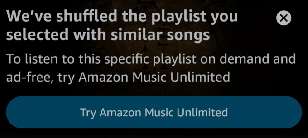
No, we're going to play what we want to play.
This is followed by "Like Fear, Like Love", the sixth song.
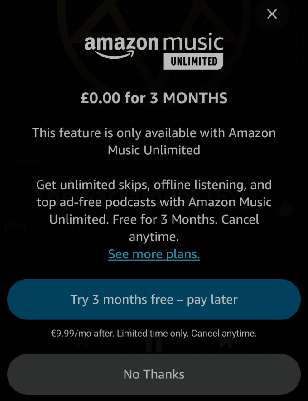
I'm sorry Dave, I'm afraid I can't do that.
In other words, useless if you aren't interested in whatever crap is "popular" right now.
You can skip titles that you don't like, and I really didn't like that, but there are only a limited number of skips available before you have no choice but to listen to the entirety of the song.
Plus there's still Prime Video, not that I've watched anything in a while. I'm hoping their buying of MGM will bring some titles worth watching sometime soon...
Bandcamp
As for listening? Well, I can always rip stuff from YouTube, or save the streaming-quality (128kbps) MP3s from Bandcamp. Or, you know, just buy an album from Bandcamp. Most of them are about $10, which is a little under €10.
I've just had a look at "Walking With Strangers". $10 to buy the album digitally, or $13 to buy it with a CD included. That's bizarre pricing.
Sadly, it's a Canadian group, so it's €12.19 for the download/CD plus another €12.19 for shipping to France.
Unzipping it into a subdirectory in /Music (on my phone) and BlackPlayer adds it to the available media and loads the cover art. I'm currently listening to it via my internet radio in Bluetooth mode.
Given this, and the range of available download options, I wonder if I need an actual CD for future purchases? Well, let's see when and what turns up. I'll keep you posted.
Sorry, Amazon, but I can't help but think that the changes to the Music app are a bit of an own-goal. Certainly, a quick look at the support forums demonstrate that I'm not the only person miffed about these ridiculous limitations.
The Birthday What?
I was listening to a goth metal streaming station a while back when along came a really nice song called "Remember Me" by a group called The Birthday Massacre (from the album mentioned above).
I remember thinking to myself that it was a really odd name for a group, and then... I promptly forgot about it. My memory is like that.
That time I remembered it. Watched the video of the song on YouTube and...
The group was formed in 1999, and the only comment that I have is why the hell hadn't they appeared on my radar before?
Denver IR-135B teardown
Okay, so yesterday I reviewed the internet radio. Now time to see what makes it tick. Or an excuse for various electroporn photos. Whatever.
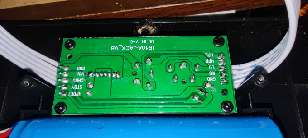
The rear circuit board.
On the right, the audio connections (not shielded wires, but you probably wouldn't expect that at this price point). Left and right for the headphones, left and right at line level, and a ground which is notably not the same as the power ground.
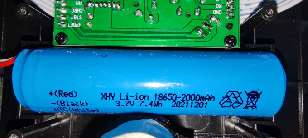
The battery.
What this is, is a built-in thermocouple. so the charging circuit can monitor the temperature of the battery.
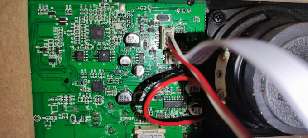
The main board.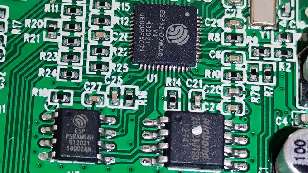
ESP32 and support.
Audio decoding.
It offers various output channels, automatic muting (if headphones connected), a five band equaliser, 3D separation, etc etc.
The other board is the LCD. It is likely to be one of the many 18 bit (RGB666) driver chips such as the ILI9341 or ST7789V, most likely running in 16 bit (RGB565) mode to reduce memory use...65,536 colours.
And, yes, these chips treat the display as 240 pixels across and 320 down as they are intended for phones, so they are being used 'sideways' here, as I thought yesterday.

Visual comparison.
On the right, a 32K-colour version of the same image (RISC OS doesn't have a 65K colour mode, so ChangeFSI only offered to do 32K). It will suffice for comparison, especially given that the 65K or 262K (controller native) might be more than the little LCD is actually capable of reproducing.
Looking at the photo, I'm going to guess the top is Gnd, then Vcc (3.3V?). The third pin would appear to connect, eventually, to the fifth pin across the top of the ESP32, which is U0TXD, so this is serial TX. Thus the bottom pin must be serial RX.
esptool.py to read the flash.
Servicing
I'm having my car serviced on Wednesday. There's still about 480km left out of my 5000km between services, or around 430km after two days of work.
I thought about driving to one of the bigger towns to go shopping yesterday. I got up, looked at the weather, went back to bed. The day didn't improve.
I sent a text message to the salesman at CNU Ouest (the vendors) on the 14th of December. I wanted them to do it because they could hook up diagnostics to see why the ABS was unhappy.
Not a peep. Not a word. Nothing.
So the local guy gets my business.
Rick, 8th January 2023, 18:02
With the exception of Power & Home at the same time, as that's the basic reset press. ;)Zerosquare, 9th January 2023, 08:50
You could use a regular two-wires 18650 cell and add a NTC resistor yourself, as long as you stick it close enough to the cell.
And the CS4230 is a speaker amplifier, indeed.C Ferris, 9th January 2023, 11:30
One of the RO types was into connecting to his car - might be of interest to you :-)Rick, 9th January 2023, 14:23
In my experience, companies don't like parting with source code. To them it's deep dark magic, commercial secret, etc.
If the company (which I think is http://aldtech.com/) was interested in making the source available, it would be on GitHub by now...David Pilling, 9th January 2023, 18:25
Interesting - they're big in open source, so there you go. Also boast of
"World's fastest power-to-play Internet radio solution (6~8 seconds)"
I remember when radios had to warm up.Rick, 9th January 2023, 19:25
I can believe 6-8 seconds. Mine takes a little longer asi have set the bigger buffer size, but it's about right.
Yes, I had a valve radio once. Mom got rid of it because a valve died and finding a replacement without internet access was next to impossible.
I do have a little record-player-in-a-briefcase that has a valve amp inside.
Oh, and when I was a teenager, a black and white valve TV, that demonstrated to me why mom had a fear of things like that bursting into flames... It must have run on something like 90~110V, and the way it obtained this was a long coil of wire wrapped around a ceramic rod that glowed red.
Yup, a television in a wooden box with a cardboard back had a bloody bar heater inside to drop the voltage.
You know, back when one could spaff away electricity and not break the bank...
Still, what the hell?David Pilling, 10th January 2023, 01:32
Compared to 50 years back so much of electronics is about transforming voltages.
Anyway you can enthuse about the valve sound.
There was a BBC News item about vinyl outselling CDs, and the punters interviewed said "much better than digital", hope they're not using USB turntables or Class D loud squeekers.
Bit like smoking, if they invented valves now, they would be banned.Anon, 11th January 2023, 20:43
Myself and a friend did some comparisons a while back between vinyl and CD sound. All other things being equal (eg both vinyl and CD taken from the same master), the digital version always sounded better. Cleaner, more detail, no pops or clicks, lower noise floor, no distortion.
And then there's coloured vinyl. Traditionally vinyl records are black because the manufacturers add "carbon black" to the mix (pure vinyl is actually transparent). This increases the rigidity and hardness of the finished record, thereby improving longevity and sound quality. But no, a lot of modern vinyl pressings are clear or coloured vinyl, produced by leaving out the carbon black and adding dyes. This does no favours for sound quality, but the hipsters love it.
Still, I'm happy with the 'vinyl revival'. The hipsters can go spend £30 on a new release vinyl album. I'll pick up the CD for £8 or so. Which I can then rip to the PC and have it in perfect quality wherever I happen to be. [1]
[1] Admit it, nobody can actually hear the difference between an uncompressed WAV file and a LAME-encoded MP3 file at anything over 256Kbit, no matter what so-called 'audiophiles' tell you.Rick, 11th January 2023, 21:31
I don't think the CD comparison holds though. There's no reason why one cannot play and listen to a CD album. I listened to my Nightwish album from beginning to end. With headphones.
While CD ought to always sound better (44.1kHz at 16 bit is plenty), one of the biggest criticisms against CD is the vast number of really awful mix jobs. This wasn't possible to do with records (or they would have) because of physical limitations.
It's also worth noting that what you hear is NOT what is actually present on the record. The sound from the stylus passes the RIAA filter to make it sound "correct". So all of this CD versus vinyl stuff is highly subjective hot air. And, as you say, there's the little clicks from specks of dust...
I wasn't aware that the black was added carbon. I suppose leaving that out, for the desire to look awesome, will make the record less.... solid? durable? what's the word here?
I think it *may* be possible to tell the difference if you know exactly what to look for. I guess it's the audio equivalent of blocky edges in video. That being said, I think that most people won't know what to look for. They are more likely to be guided by external factors.
I'll give you an example. I used to listen to The Eagle broadcasting from Guildford. I don't know if they used the last valve transmitter in the country or if it was an odd equaliser mix, but it was pretty easy to find on the radio because they had a "warm" sound. I can't describe it in any other way. It was "warm".
Well, if your audio decoding software futzes with the sound, it might sound better not because it's essentially the same thing, but because it has a more pleasing result. Like the modern version of fiddling with the tone knob.
To this end, it's known that people tend to rate lame encoded MP3s better than others.
I'll also admit that I doubt that people can actually tell the difference between 44.1kHz and 48kHz sampling rates, when played on equipment capable of handling that sampling rate natively (so no aliasing from one to the other which will distort the sound).
Anon, 19th January 2023, 22:37
I *believe* that Spotify re-encodes on the fly, possibly from a lossless file repository. Of course, in order to do this without pegging the load average of the server, it would have to use a "fast" encode mode. With LAME, the difference between -q0 (slow, highest quality) and -q9 (fast, poor quality) is immediately audible on anything better than standard PC speakers.
Using -q0 along with -V0 (variable bitrate, highest quality) and -mj (joint stereo, flips between LR and MS encoding for each frame depending on what's most efficient) then no, you won't hear a difference, even on really high end kit. Or a set of studio monitors. (Trust me, I've tried it. I've also tested my hearing and it goes up to about 19kHz - although in my mid-teens I could hear up past 21kHz.)
Re-reading my previous comment, by "streaming" I meant "rip the CD yourself, stick it on the music server and play it over the network", rather than Spotify, Amazon etc.
I suppose I'm in the minority. I tend to put on an album (CD rip), dim the lights and play it right through, beginning to end. Sounds like you often do the same thing.
BBC Radio 2 has a "warm" sound, at least on FM. Don't get me started on DAB in the UK - a codec designed to be run at a minimum bitrate of 256Kbit, all the BBC stations apart from Radio 3 run at 128Kbit, with Radio 3 running at 160Kbit. DAB uses the MP2 codec, also used for standard def TV channels (HD channels use AC3 or AAC). The difference being on DVB, the audio runs at 256Kbit on the BBC channels - including radio.
My understanding from a BBC engineer is that everything internally runs at 24-bit 48kHz over AES/EBU digital links (the SPDIF connector on most consumer kit is a subset of AES/EBU) until it reaches the transmitter. At that point, the FM signal is run through a DAC and fed into the transmission network. The DAB signal used to be downsampled to 32kHz, 14-bit, although nowadays I think they transmit at 16/48. (I may be thinking of the NICAM system that ran at 32kHz 14-bit u-law.) It's then encoded using the MPEG Layer 2 (MUSICAM) codec. The point being, it's all kept digital right up until it reaches the FM transmitter, then run through a high quality DAC before being fed into the multiplexer and modulator.
The choice of sample rates wasn't arbitrary. The reason CDs use 44.1kHz is because they were originally authored using a Sony PCM-1640 digital processor, which recorded the digital audio onto the video track of a U-Matic VCR. By using 44.1kHz it was possible to fit a whole number of samples per frame on either a PAL or NTSC recorder.
The change to 48kHz for film and DVD sound happened when movie soundtracks started going digital, for similar reasons to the 44.1kHz rate. Essentially, 48kHz divides exactly into 24, 25, 30, 50 or 60, meaning that whether using cinematic cadence (24-frame), PAL (25p or 50i) or NTSC (30p or 60i) then you'd have a whole number of audio samples per frame of film or video, thus simplifying editing and retaining sync. There's no audible difference, it's done purely to make it easier to keep the audio and video in sync.
| © 2023 Rick Murray |
This web page is licenced for your personal, private, non-commercial use only. No automated processing by advertising systems is permitted. RIPA notice: No consent is given for interception of page transmission. |